Morphological and morphometric study of the androgenetic alopecic scalp using two- and three-dimensional analysis comparing regional differences
June 2014
in “British Journal of Dermatology”
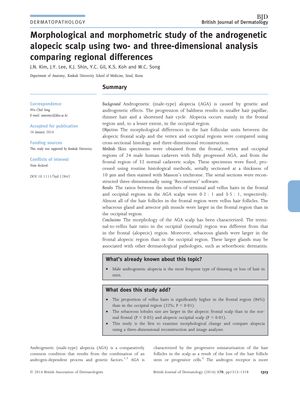
TLDR The study found that balding scalps have more thin hairs and larger oil glands, which might contribute to skin conditions related to hair loss.
The study analyzed the scalp of 24 male cadavers with advanced androgenetic alopecia (AGA) and compared it with 32 normal scalps, using histological methods and three-dimensional reconstruction. It found significant differences in the ratio of terminal to vellus hairs, with the AGA frontal region having a much higher proportion of vellus hairs (86%) compared to the occipital region (22%). The sebaceous glands and arrector pili muscles were also larger in the frontal region. These morphological changes, including narrowed follicular canals and enlarged sebaceous lobules, may be linked to seborrhoeic dermatitis. The study, involving cadavers with an average age of 76.7 years, suggested that the observed miniaturization of hair follicles and the attachment of the arrector pili muscle to the dermis rather than the hair follicle could affect sebum secretion and contribute to dermatological conditions associated with AGA. This was the first study to use three-dimensional reconstruction to examine these changes in AGA.
View this study on academic.oup.com →
Cited in this study

research Bald scalp in men with androgenetic alopecia retains hair follicle stem cells but lacks CD200-rich and CD34-positive hair follicle progenitor cells
Men with baldness due to androgenetic alopecia still have hair stem cells, but lack specific cells needed for hair growth.
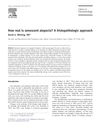
research How real is senescent alopecia? A histopathologic approach
Aging alone rarely causes significant hair loss; hormones are a bigger factor.
research Comparative Histopathology of Androgenetic Alopecia, Diffuse Alopecia, and Senescent Alopecia

research Comparative Gene Expression Profiling of Senescent and Androgenetic Alopecia Using Microarray Analysis
SA linked to mitochondrial issues and oxidative stress, while AGA involves disrupted hair growth genes.

research Hair counts in scalp biopsy of males and females with androgenetic alopecia compared with normal subjects
AGA patients have fewer hairs and smaller follicles; T:V ratio above 4:1 may indicate AGA.

research Evaluation and treatment of male and female pattern hair loss
Early diagnosis and treatment, using finasteride, minoxidil, or hair transplantation, improves hair loss outcomes.

research Androgenetic alopecia in men and women
Androgenetic alopecia involves genetics, hormones, and can be treated with medications or surgery.
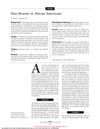
research Hair Density in African Americans
African Americans have less hair density than whites.

research Different Levels of 5α-Reductase Type I and II, Aromatase, and Androgen Receptor in Hair Follicles of Women and Men with Androgenetic Alopecia
People with hair loss have more androgen receptors and enzymes in certain follicles, with men and women showing different patterns.

research Diagnostic and predictive value of horizontal sections of scalp biopsy specimens in male pattern androgenetic alopecia
Horizontal scalp biopsy sections effectively diagnose and predict MPAA, with follicular density and inflammation impacting hair regrowth.
Related

research 63-Year-Old Female with Diffuse Thinning of the Hair
Androgenetic alopecia, a common hair loss condition, can be treated with topical minoxidil, oral finasteride, or oral spironolactone, and new treatments like platelet-rich plasma, low-level laser therapy, and janus-kinase inhibitors are being explored.

research Hair loss (alopecia or baldness)
Baldness is often hereditary and linked to male hormones, becoming noticeable when half the hair is lost.

research Body to scalp: Evolving trends in body hair transplantation
Body hair transplants can treat baldness but differ from scalp hair and need more research on long-term results and side effects.

research Morphological and morphometric study of the androgenetic alopecic scalp using two- and three-dimensional analysis comparing regional differences
The study found that balding scalps have more thin hairs and larger oil glands, which might contribute to skin conditions related to hair loss.

research Use of Micrografts and Minigrafts in Hair Restoration
Micrografts and minigrafts for hair restoration provide high patient satisfaction and can cover large areas of hair loss, including sideburns, eyebrows, and beards.
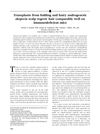
research Transplants from balding and hairy androgenetic alopecia scalp regrow hair comparably well on immunodeficient mice
Hair from balding and non-balding areas regrows similarly on mice.
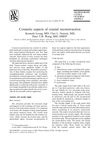
research Cosmetic aspects of cranial reconstruction
The article concludes that cranial reconstruction should aim for the best aesthetic result, using various techniques tailored to individual needs and conditions.
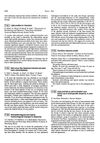
research Histopathologycal and topical immunologycal changes in alopeciae
Autoimmune and inflammatory processes are involved in both scarring and non-scarring types of hair loss.